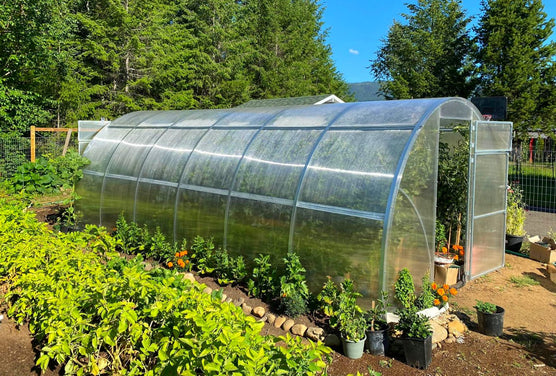Industrial Expanding Solutions: Monarch Commercial Greenhouse Utah Innovations
Wiki Article
The Future of Greenhouses: Developments in Sustainable Farming
Are you curious concerning the future of greenhouses and exactly how they are revolutionizing lasting farming? Look no additional! In this write-up, we will check out the amazing developments that are leading the means for a greener and much more reliable farming industry. From sophisticated environment control systems to vertical farming methods, water-efficient watering approaches, renewable resource combination, and clever information analytics, these developments are transforming the means we expand our food. Prepare yourself to find the future of lasting agriculture in greenhouses!Advanced Climate Control Equipment
To accomplish ideal expanding conditions, you can count on the innovations in greenhouses with advanced climate control systems. These systems have transformed the way we cultivate crops, supplying a regulated atmosphere that is favorable to plant growth. With these ingenious systems, you can now manipulate temperature, moisture, light degrees, and even CO2 concentrations to create the excellent problems for your plants to prosper.Among the essential features of these advanced environment control systems is their capacity to control temperature. By using sensing units and automated controls, the greenhouse can readjust the temperature based on the specific demands of the plants. This makes certain that they are never ever subjected to extreme warmth or cool, which can be detrimental to their development.
Moisture control is one more important facet of these systems. By preserving the perfect humidity degrees, you can prevent concerns such as mold and mildew, mold, and disease from influencing your crops. These systems can also control the amount of light that reaches the plants, ensuring that they get the ideal quantity for photosynthesis.
In addition, advanced environment control systems can even adjust CO2 focus. By boosting the levels of carbon dioxide in the greenhouse, you can enhance plant development and productivity. This is specifically helpful in areas with reduced all-natural CO2 degrees.
Upright Farming Methods
One essential vertical farming strategy is using stacked expanding systems. Stacked growing systems are generally used in metropolitan areas where area is restricted.One popular method is referred to as vertical hydroponics, where plants are grown in nutrient-rich water without dirt. This technique is extremely efficient as it minimizes water usage by as much as 90% contrasted to standard farming methods. Furthermore, considering that the plants are expanded inside, they are shielded from parasites and diseases, decreasing the requirement for chemicals.
An additional strategy is aeroponics, which entails putting on hold the plant origins in a haze or air setting. This method enables optimum nutrient absorption and oxygenation, resulting in faster growth and higher returns. Aeroponics also uses much less water than traditional farming and can be implemented in vertical systems, making it a popular choice for vertical farming.
Water-efficient Watering Approaches
When it comes to implementing water-efficient watering approaches in sustainable agriculture,Maximizing water preservation is necessary. With worldwide water scarcity coming to be a pushing issue, it is crucial to create ingenious techniques that maximize water usage in greenhouse procedures.One appealing technique is drip watering, which provides water directly to the plant origins, reducing waste and dissipation. By utilizing a network of tubes with small emitters, water is used gradually and precisely, guaranteeing that plants receive the needed wetness without excess runoff.
One more effective technique is making use of dirt dampness sensing units. These gadgets determine the moisture content in the soil and give real-time information to farmers. By checking the soil's wetness degrees, farmers can precisely establish when and exactly how much water to use, avoiding over-irrigation.
Additionally, the implementation of rain harvesting systems is obtaining appeal in greenhouse agriculture. Accumulating rainwater from rooftops and saving it in storage tanks allows farmers to use this natural deposit for irrigation objectives, minimizing reliance on typical water sources.
Lastly, the fostering of automated irrigation systems can significantly boost water effectiveness. These systems use sensing try here units to discover dirt wetness levels and climate condition, readjusting irrigation timetables accordingly. By maximizing water usage based upon actual plant demands, these systems can minimize water waste and promote lasting farming practices.
Renewable Power Combination
Eco-friendly power integration in greenhouses provides a number of benefits, consisting of reduced operating costs and lowered dependence on non-renewable energy sources. The generated power can after that be made use of to run numerous procedures within the greenhouse, such as illumination, heating, and ventilation systems. These generators harness wind power and convert it right into power, which can be utilized to supplement the energy demands of the greenhouse.Smart Data Analytics and Automation
To improve the performance of your greenhouse operations and enhance source usage, take into consideration carrying out smart data analytics and automation. Smart data analytics entails accumulating and evaluating information from numerous sensors and gadgets within your greenhouse.
This can consist of automating the control of illumination, air flow, irrigation systems, and nutrient shipment. By automating these processes, you can make sure that your plants get the appropriate conditions and nutrients at the right time, without the need for constant manual treatment.
Furthermore, smart information analytics and dog grass automation can interact synergistically. The data accumulated by sensing units can be made use of to notify automatic systems, enabling them to make real-time adjustments based on the existing problems. This combination of data analytics and automation can result in much more accurate and efficient source appropriation, inevitably causing greater yields and much better crop quality.
Conclusion
In verdict, the future of greenhouses in sustainable agriculture looks appealing. With sophisticated climate control systems, vertical farming strategies, water-efficient irrigation methods, and sustainable power combination, greenhouses are becoming a lot more ecologically friendly moved here and reliable.
By enhancing water use based on real plant demands, these systems can decrease water waste and advertise lasting farming techniques.

Report this wiki page